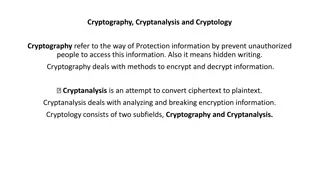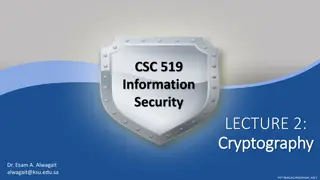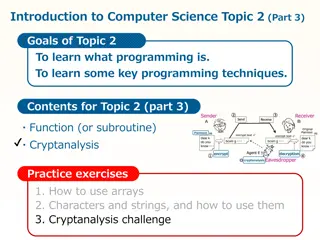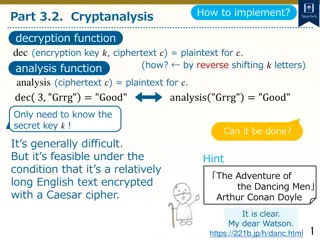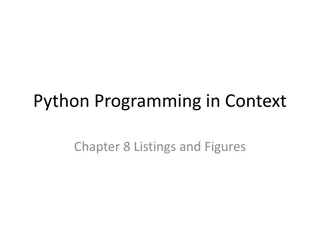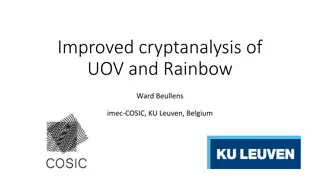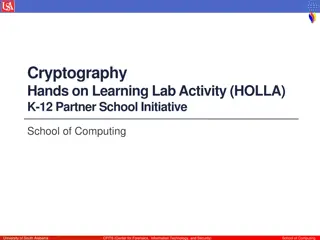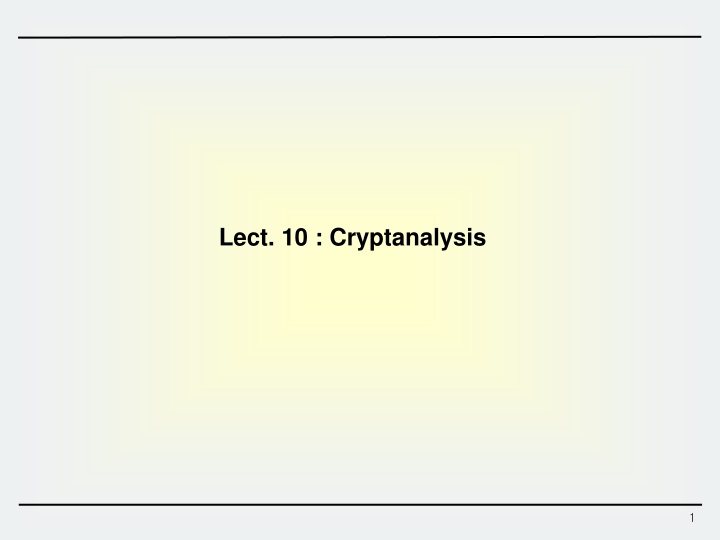
Cryptanalysis Techniques for Block Ciphers
Explore the various cryptanalysis techniques used for breaking block ciphers, including statistical analysis, differential cryptanalysis, linear cryptanalysis, and more. Learn about attack scenarios, key schedule cryptanalysis, and side-channel cryptanalysis methods to understand how encryption schemes are vulnerable to different types of attacks.
Download Presentation

Please find below an Image/Link to download the presentation.
The content on the website is provided AS IS for your information and personal use only. It may not be sold, licensed, or shared on other websites without obtaining consent from the author. If you encounter any issues during the download, it is possible that the publisher has removed the file from their server.
You are allowed to download the files provided on this website for personal or commercial use, subject to the condition that they are used lawfully. All files are the property of their respective owners.
The content on the website is provided AS IS for your information and personal use only. It may not be sold, licensed, or shared on other websites without obtaining consent from the author.
E N D
Presentation Transcript
Block Cipher Attack Scenarios Attacks on encryption schemes Ciphertext only attack: only ciphertexts are given Known plaintext attack: (plaintext, ciphertext) pairs are given Chosen plaintext attack: (chosen plaintext, corresponding ciphertext) pairs Adaptively chosen plaintext attack Chosen ciphertext attack: (chosen ciphertext, corresponding plaintext) pairs Adaptively chosen ciphertext attack E D K K Plaintext Ciphertext Plaintext Ciphertext Decryption Oracle Encryption Oracle 2
Cryptanalysis of Block Ciphers Statistical Cryptanalysis Differential cryptanalysis (DC) Linear Cryptanalysis (LC) Various key schedule cryptanalysis Algebraic Cryptanalysis Interpolation attacks Side Channel Cryptanalysis timing attacks differential fault analysis differential power analysis, etc. 3
Cryptanalysis of Block Ciphers - DC Differential Cryptanalysis E. Biham and A. Shamir : Crypto90, Crypto92 Chosen plaintext attack, O(Breaking DES16~ 247) Look for correlations in Round function input and output (DES : 247) high-probability differentials, impossible differentials truncated differentials, higher-order differentials * E.Biham, A. Shamir, Differential Cryptanalysis of the Data Encryption Standard , Springer-Verlag, 1993 Input difference X = X X Statistically non-uniform probability distribution: higher prob. for some fixed pattern X & Y Prob. E K Y = Y Y Output difference 4
Cryptanalysis of Block Ciphers - LC Linear Cryptanalysis Matsui : Eurocrypt93, Crypto94 Known Plaintext Attack, O(Breaking DES16) ~ 243 Look for correlations between key and cipher input and output linear approximation, non-linear approximation, generalized I/O sums, partitioning cryptanalysis * M. Matsui, Linear Cryptanalysis Method for DES Cipher , Proc. of Eurocrypt 93,LNCS765, pp.386-397 Input X Linear equation between some bits of X, Y and K may hold with higher prob. than others E K Output Y 5
Other Attacks on Block Ciphers Algebraic Cryptanalysis deterministic/probabilistic interpolation attacks Key Schedule Cryptanalysis Look for correlations between key changes & cipher input/output equivalent keys, weak or semi-weak keys related key attacks Side-Channel Cryptanalysis timing attacks differential fault analysis differential power analysis, etc. 6
Side Channel Traditional Cryptographic Model vs. Side Channel Power Consumption / Timing / EM Emissions / Acoustic Attacker C=E(P,Ke) P=D(C,Kd) C P D E() D() Insecure channel Kd Ke Secure channel Key Radiation / Temperature / Power Supply / Clock Rate, etc. 7
Model of Attack -Embedded security 8


